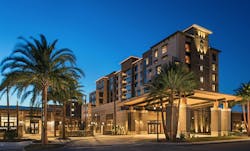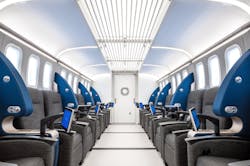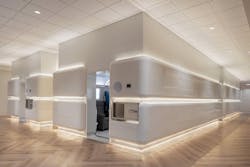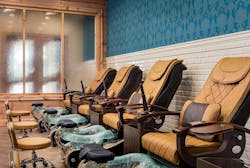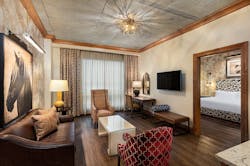DPR-led project team completes the largest hyperbaric oxygen therapy center in the U.S.
GOLD AWARD
The Center for Advanced Healthcare at Brownwood and Brownwood Hotel & Spa
The Villages, Florida
Project Information
Project size: 250,000 sf (CAHB); 215,000 sf (Brownwood Hotel & Spa)
Project cost: $127 million
Construction time: July 2018 to March 2020
Delivery method: CM GC-CM at risk
Building Team
Submitting firm: DPR Construction (CM/GC)
Owner: The Villages and Brownwood Hotel & Spa LLC
Architect of record: Earl Swensson Associates
Structural engineer: Structural Design Group
MEP engineer: Phoenix Design Group
Plumbing engineer: Nash Plumbing & Mechanical
Electrical contractor: Electrical Services Inc.
Steel fabricator: SteelFab
Steel erector: Chacon Steel Erectors
Hyperbaric chamber engineer: Fink Engineering
Judges' Comments
"The challenge of building this multiphased project with multiple end users, plus the requirement of high craftmanship and the added challenge of including the innovative hyperbaric chamber, merited this award."
A 'bedless hospital' and hotel/spa, all in one
The Center for Advanced Healthcare at Brownwood (CAHB) and Brownwood Hotel & Spa project is a 31-acre development with >400,000 sf of interior space anchoring the west side of The Villages’ Brownwood Paddock Square town center. The medical and hospitality components of the bedless hospital and 150-room hotel and spa were developed to meet the needs of the local community as well as the residents and guests of a neighboring continuing care retirement community.
The five-story CAHB is the first phase of a long-term ambulatory care program that will provide ambulatory surgery, audiology, cardiology, dermatology, endocrinology, gastroenterology, gynecology, hyperbaric oxygen therapy, testing laboratories, neurology, occupational therapy, oncology, ophthalmology, orthopedics, pain management, podiatry, pulmonary, pharmacy, physical therapy, rheumatology, radiology, speech therapy, and urology.
The project team’s most notable achievement was the delivery of the largest hyperbaric oxygen therapy center in the United States. HBOT is a treatment where pressurized pure oxygen circulates through an enclosed environment, allowing the body to take in increased oxygen levels to stimulate regeneration, healing, stem cell, and growth factors in the body.
Largest hyperbaric oxygen therapy center in the U.S.
The Aviv Clinic team at the Center for Advanced Healthcare at Brownwood is focused on the science of aging. In 2020, DPR Construction completed the CAHB’s 30,000-sf state-of-the-art hyperbaric oxygen therapy facility, providing the medical team with a new way to offer data-driven research aimed at improving the performance of the brain and body. Getting this result took close collaboration among project team members, a Lean approach that cut schedule, and a team with the technical know-how to cover every detail in a sensitive environment.
Located in The Villages, a rapidly growing area 55 miles northwest of Orlando, Fla., the custom-designed hyperbaric suites are housed in one of the largest specialized cognitive therapy centers in the United States.
“This is a first-of-its-kind facility in both scale of deployment and in the United States,” said DPR Project Executive Bill Hawthorne. DPR was able to anticipate project outcomes and precision execution by leveraging its self-perform labor force for many of the scopes on this project.
“I was first introduced to the science of hyperbaric oxygen therapy during a trip to Israel by Dr. Shai Efrati at his medical center in Tel Aviv,” said internal medicine specialist Elliot J. Sussman, MD, Chair at The Villages Health. “I was intrigued by the research studies on the effect of hyperbaric oxygen therapy as administered by Dr. Efrati’s protocols on a variety of conditions,” said Sussman. Following a series of meetings and two tours of Efrati’s operations in Tel Aviv by the project team, the idea to move forward with construction in Florida became a reality.
“We’ve set a new standard in hyperbaric facilities," said Sussman. "The vision was to be able to offer this unique service and focus clearly on reverse aging in older adults who want to maintain their vitality. We also recognized early on that other people would want access to the facility.”
Chamber design and installation coordination
Fink Engineering, Queensland, Australia, combined an innovative design approach with state-of-the-art engineering and fabrication facilities to redefine the form and function of medical hyperbaric chambers.
“The rectangular shape is unique to Fink Engineering,” said Eric Fink, the firm’s Managing Director. The Aviv chambers were designed to set a new standard for temperature control, lighting design, and technology integration. “Aviv Clinics’ chambers around the world will be modeled after the Villages clinic,” he said. The design has recently been implemented in the newest Aviv Clinic, in Dubai, UAE.
The project team was aware that the HBOT chambers would require direct access to the exterior shell structure for delivery, installation, and future replacement. “Developing solutions as a fully integrated team committed to working together on the front end, the teams shared a similar mindset of being proactive, creative, and flexible throughout the project,” said Katie Jacoby, Executive Vice President, Strategy & Development, Anchor Health Properties.
The project team engaged DPR’s VDC expertise early on to ensure seamless MEP coordination. “The chambers presented the challenge of how to phase the project while awaiting delivery, and then later how to get the chambers in place. The way the construction team figured out how to maneuver them into place was amazing,” said Ryan Malloy, a mechanical engineer with Phoenix Design Group.
The design of the complex network for oxygen flow, exhaust, controls, and electrical infrastructure, coupled with the coordination of equipment, piping, ventilation, and electrical, will serve as the blueprint for future HBOT facilities.
Malloy says the DPR team helped the engineers from Australia bridge gaps in their knowledge of U.S. code requirements. “They helped navigate the complexities of the infrastructure of the hyperbaric chamber systems that many building code officials may not have been exposed to previously,” said Malloy.
“The surety of delivery was paramount for this project, as the unique nature of the development required creative planning solutions. DPR’s collaborative approach to preconstruction, procurement, and construction planning provided great value to us as a client,” said Brian Sellers, development and construction manager at The Villages.
Systems stand up to the Covid pandemic test
The Villages’ center can provide service to 56 clients in its two chambers. Each chamber has two separate compartments, each of which has seating for 14 clients and a nurse during a two-hour session. With current COVID social distancing parameters, the team has limited the maximum capacity to seven clients per session. At full capacity, the center can treat 1,200 clients per year.
Treatment involves sitting in a cushioned seat while receiving pressurized pure oxygen through a mask (similar to a CPAP mask). The process stimulates the body’s rejuvenation process and provides insight into how the brain looks and functions. “HBOT has the potential to reverse the pathology and symptoms of aging by supporting the improvement of cognitive and physical performance,” said Dion Atchison, Head of Operations, Aviv Clinics. While in the chamber for the two-hour session, clients alternate breathing in compressed room air and stretch during four separate five-minute pure oxygen air breaks, where clients replace their oxygen mask with their COVID protocol mask. “Within the chamber, there hasn’t been a single documented case of COVID transmission,” said Sussman.
One campus, multiple tenants
The CAHB started as a greenfield, new construction project which broke ground in early 2018 and received its certificate of occupancy two years later.
The Villages, The Villages Health, and Anchor Health Properties wanted to extend the success of the innovative primary care model that they co-developed nine years ago, in order to better provide world-class treatment to the ever-growing population of central Florida.
The 250,000-sf, 75-foot-tall brick, stone, and EIFS structure overlooks two lakes to the north. It shares a courtyard with the Brownwood Hotel and Spa and the poolside Wolfgang Puck Restaurant, both of which were built by DPR.
The CAHB houses the practices of >25 clinical specialists. DPR’s Quality Control efforts saw the resolution of 6,031 issues through the BIM 360 Field software. DPR used its ability to self-perform the concrete, drywall, specialties and doors frames & hardware scopes to its advantage. The DPR team installed more than 12,000 cubic yards of concrete, 700 cubic yards in the walls and ceiling of the linear accelerator vault alone.
DPR Specialties installed all Division 10 accessories. DPR self-performed the installation of >1,000 doors, frames, and hardware. Electrical Services Inc. brought >7,600 amps of power into the building. SteelFab brought in >1,400 tons of Class A fabricated structural steel and used the SidePlate steel frame connection system to permit Chacon Steel to erect it safely and efficiently. Nash Plumbing & Mechanical installed >550 plumbing fixtures, >850 tons of cooling systems, >18.5 miles of plumbing and HVAC piping, and 160 tons of sheet metal duct.
DPR also installed a patient lift system and a wide range of imaging equipment – HDR, CT simulator, MRI, CT, PET/CT, ultrasound, X-ray, nuclear medicine, fluoroscopy, densitometer.
The CAHB features a sweeping radius structure leading to the main entrance. A brick paver path leads beneath a large radiused canopy, opposing the building’s radius, funneling in to a “floating” vestibule. The main lobby is open and lit during the day by the large radiused curtain wall, with automatic blinds for sun filtering. It has a high ceiling adorned in 6-inch millwork on coffered drywall with a faux-wood Rulon ceiling inlay forming a centric wagon-wheel pattern, whose spokes conceal the services within. This pattern, also represented in the floor pattern, draws patients from the information desk on the first floor to the center of the building near the first and second floor patient elevator lobbies.
Neutral and stained shiplap covers the walls with pops of color coming from casework, accent paint, or one of 32 types of wallcovering. Two six-foot custom chandeliers hang in the coffered ceiling between the two, two-story ornate GFRC- and millwork-wrapped columns and the oak newels with ornate railing leading down the white terrazzo stair to the information desk.
To the west, from the main lobby the CAHB’s living room corridor where the stamped leather and ostrich skin furniture sits between interior exposed masonry columns and below 24 wood sphere chandeliers. However, if you were to venture to the east of the lobby, through the sliding doors on the left, you would enter the Aviv Clinic’s lobby where its clean modern lines and exotic wood would be more reminiscent of Westworld. The abundance of tenants resulted in varying, space specific finish sets to match each group’s interpretation of Brownwood’s Western-Chic theme which, even when mixed with the tenant’s own selections, turned out great under the watchful eye of our interior design team. DPR’s top-notch Project Engineers, among so many other amazing feats, did an incredible job procuring each of these samples and verifying their installation.
From the meticulous care taken to ensure the site’s readiness for each piece of equipment, to ensuring that the evolving design of the family-owned coffee shop, The Standard Cup, resulted in a finished space they could be proud of. The varietal nature of this project allowed DPR’s own versatility to shine. The team’s dedication to leave our customers impressed and the care, given to the needs of our customers, ensured its success.
The Center for Advanced Healthcare at Brownwood is connected to The Villages’ more than 100 miles of golf cart paths and is situated near the Villages Brownwood Paddock Square Town Center. For commuters, this location can also be conveniently accessed by other nearby cities and transportation hubs situated just 30 minutes from Ocala, and only an hour away from Tampa, Orlando, and Gainesville.
Aesthetics strategy combines with Lean construction
Aviv Clinics and The Villages teams provided designer Earl Swensson Associates with clear goals of their functional, operational, and marketing vision for the center including creating an experience of hospitality over a clinical environment. “The interior architecture has a welcoming, clean, and uncluttered brand, with a notable presence of technology throughout the Aviv center,” said Sam Burnette, Principal, Earl Swensson Associates.
Working closely with Aviv’s team of global consultants, the project team focused their attention on the design goals of clear wayfinding, upscale locker room and bathing spaces, access to physicians and technical staff areas, and incorporating natural lighting wherever possible throughout the center. Burnette says Earl Swensson Associates initially designed the space as a two-story facility. Upon further review, a one-story design proved to be the best solution.
“Modifications to interior amenities were needed but the interiors brand and quality of materials were not compromised,” said Burnette. In several cases, the design team and DPR were able to find alternative finishes, lighting, and bathroom fixtures that had equal or better performance than costlier items originally proposed.
Speed to market was a crucial differentiator for Anchor Health Properties. “We were able to leverage self-performing resources to dramatically advance the project, ultimately shortening the timeframe to engage our trade partners’ expertise and achieve real-time market impact. This early investment in collaborative knowledge-sharing helped to reduce risk, improve quality, and increase value for this project,” said Richard Paddock, Vice President, Development at Anchor Health Properties.
Paddock said the team’s collective budgeting expertise helped compress the procurement timeframe in the preconstruction phase. “By presenting a development budget with certainty and current market numbers, we helped the client expedite consensus and approval,” said Paddock.
The second floor of the healthcare facility connects to The Brownwood Hotel & Spa. This boutique hotel features 150 guest rooms where medical center patients have the option of an overnight stay after procedures are performed. Its high-end finishes include stone tile with carpet inlay, pecky cypress ceilings throughout the interior and exterior of the building, hair-on-hide and fabric-wrapped panels, and leather furnishings.
The 8,500-sf ballroom features wood wainscoting and >10,000 decorative nail heads. The guestrooms are outfitted with luxury vinyl plank flooring and exposed ceilings that highlight the formwork from the post-tensioned concrete slabs. The property also features an outdoor pool, fitness center, a coffee shop, a luxury spa, and a 5,000-sf courtyard that features Western Red Cedar column wraps, beams, trusses, and ceilings beneath a bronze-finished metal roof.
Inspired by the nearby Brownwood Town Square, which is reminiscent of an early Florida cattle town, the boutique hotel’s design utilizes a warm, rustic interior and exterior material palette. The façade features locally sourced stone, brick, and brown tones, while the interior is filled with rich golds, red, and blues. The hotel features 10,000 sf of flexible meeting room and conference center space, a spa/medispa, and a lobby bar.
Additional dining options include a test kitchen, mobile food truck, and lobby market. Blurring the line between indoor and outdoor spaces, the design centers on the hotel pool and event courtyard, which has a green wall with fresh herbs for use by the restaurants.
Innovative design and construction
Several instances of innovative design and construction were applied to the project to improve the construction process and create a unique end user experience. The hotel tower exterior façade was constructed with prefabricated wall panels, which allowed the vertical enclosures of the tower to be installed and dried within a month of topping out. This accelerated the guest room interior finishes and enabled the tower to be turned over in phases for furniture, fixtures, and equipment, resulting in a start date two full months before contract substantial completion.
The property also incorporates a second-floor corridor connecting the hotel and healthcare buildings, allowing clientele of the Ambulatory Surgery Center to receive outpatient procedures and check in to the hotel for an overnight stay without ever needing to go outside.
Team works together to overcome challenges
One of the biggest challenges was that the tenant improvement packages were issued at different times based on the progress of the design. The team resequenced the original construction schedule to accommodate the issuance of the contract drawings. DPR was able to overcome late equipment selections by coordinating directly with specialty practices to keep construction activities from being delayed. In several cases the team refrained from placing slab on grade as originally sequenced in order to accommodate tenant needs.
The final drawing issuance pertained to the HBOT facility in the Aviv Clinic. The drawings for this space were issued months after those for the main building, but Aviv wanted to maintain the same completion date as the main building. Working closely with Aviv, DPR identified the long lead items, mainly the hyperbaric chambers, and developed a plan to work around them. This allowed the team to continue with the exterior framing and skin activities while carving out an area to install the chambers when they arrived on site.
The plan began way before production by understanding expectations, aligning everyone involved, agreeing on acceptance criteria by collecting knowledge and information, and then proceeding with production. Once the preconstruction aspect of quality control was complete and construction was under way, DPR followed the three steps in their plan to ensure quality of the product: 1) preinstallation conferences, 2) first-of-kind inspections (mockups), and 3) periodic follow-ups/final inspections.
DPR also coordinated specialty inspections with the required consultants and regulatory agencies, such as Geotech for structural quality and Sumter County for framing/overhead/in-wall inspections. Any remaining issues were identified during the testing and commissioning/startup process and were handled immediately.
The project team’s ability to manage the unique complexities of this project while also tending to the specific needs and requests of its various stakeholders is a feat in collaboration. The Center for Advanced Healthcare at Brownwood speaks for the hard work contributed by all.
DPR team builds digitally before performing trades work
DPR Construction self-performed all exterior/interior framing and drywall on the CAHB project and procured and installed all acoustical ceilings in the building and specialty wood-look PVC plank ceilings in the interior lobby and exterior awnings.
Many of the medical equipment rooms required lead shielding. DPR used 3D modeling and digital layout tools for its scope of work to ensure accurate placement of work within the building. DPR used its interior and exterior framing models to coordinate with the other trades to avoid equipment conflicts with critical wall framing members. By building the project digitally first DPR eliminated many potential conflicts in the field and increased overall project quality.
DPR’s scope of work took 154,000 man-hours to complete. DPR used software to track man-hours and quantities of work installed on a weekly basis to ensure to stay on track with budget and schedule. Weekly meetings with the main project team were held to discuss project issues, production data, and manpower forecasts.

